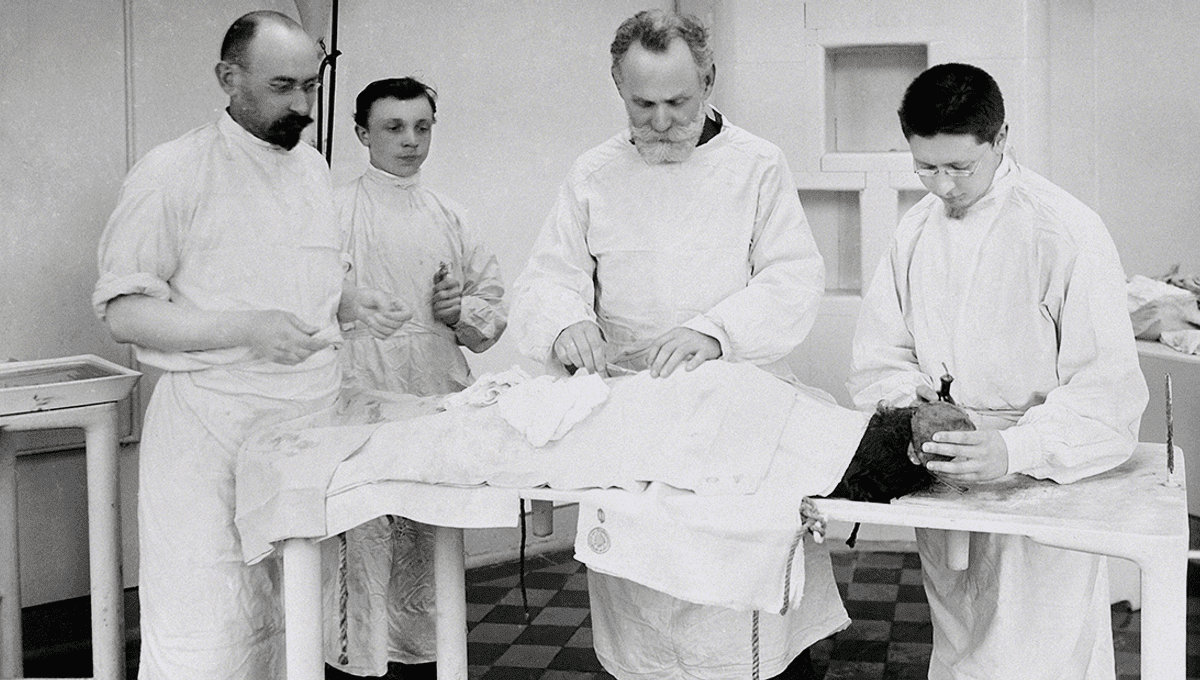
Everyone has heard of Pavlov, the wacky psychologist who figured out you could make dogs drool by shaking a bell at them when you give them food, then eventually just by shaking the bell.
As it’s taught in psychology, it’s only harmful on the level of pretending to throw a ball for a dog and the dog goes looking for it, making it look like an idiot. Well, for some reason, the popular view of Pavlov leaves out a lot of the grisly detail of what his experiments involved – probably because it’s quite distracting to mention to kids studying psychology “he ripped their throats up of course”.
First off, Pavlov’s method of measuring salivation was a lot more invasive than simply noticing Mr Floofels is drooly. Pavlov was initially interested in the effect of eating on pancreatic, gastric and salivary excretions, rather than the experiment he became forever known by. To this end, he removed the esophagus of his lab dogs, and created a hole in their throat. When the dogs ate, it would simply fall out of the hole and not make it to the stomach. Fistulas (holes) placed further along the digestive system, attached to tubes, allowed him to collect, measure, and study the gastric juices to his heart’s content.
As an added bonus, he also gathered up gastric juices from dogs in his lab and sold it in Russia, France and Germany as a cure for indigestion. To make extra money, he also hired an assistant to gather up gastric juices from the “gastric juice factory“: five large dogs harnessed to a crossbeam and attached to a container by a tube coming out of their fistulas. They were placed on an angle so that they were facing a bowl of mince meat in front of them, which the dog would eat (before it fell out of their neck holes onto a collection plate).
According to published accounts of the gastric juice factories, the dogs appeared to like these experiments and would enthusiastically jump to their stands before (kind of) eating for several hours, as they gave up their precious gastric juices to be sold. Food was placed directly into their stomachs to maintain their health, for want of a better word.
The dogs did not last long. Pavlov noted, after the death of one particularly-hardy dog ten days after its operation, that “our passionate desire to extend experimental trials on such a rare animal was foiled by its death as a result of extended starvation and a series of wounds.”
During this research, Pavlov noticed that the dogs would begin to salivate whenever they saw the white lab coat of his assistant on their way to give the dogs food. They would salivate at the site of the coated assistants alone, whether food was present or not.
Pavlov conducted experiments on this, associating different stimulus with the presence of food. No, he did not use a bell. Pavlov used a metronome, setting it going just before the dogs were fed (or at least, before they chewed some food before it plopped out of their neck hole). The dogs associated the sound of the food with the metronome, and began to salivate when they heard it, despite the non-presence of food, which he termed a “conditional reflex”.
After this horror show, which heavily influenced psychology and behavioralism as we know it today, Pavlov is now remembered for a much gentler telling of that experiment, with an instrument he never used.
We guess Pavlov’s Metronome or Pavlov’s House Of Dog Torture didn’t quite ring as well as “bell”.
Source Link: Pavlov's Dog Experiment Was Much More Disturbing Than You Think